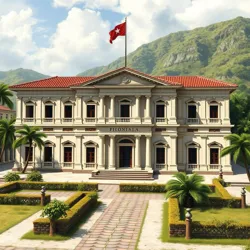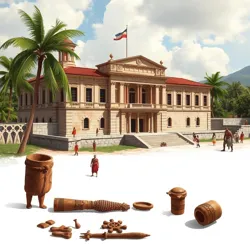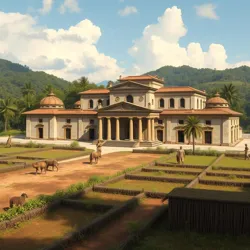Colonia Haitiana
 The Praetorium Haitianum, seat of Roman colonial government in Port-de-Balbus, built in 534 AR
The Praetorium Haitianum, seat of Roman colonial government in Port-de-Balbus, built in 534 ARColonia Haitiana (Greek: Ἁιτιανή Ἐπαρχία) is a Roman colonial territory established in 531 AR during the Great Western Expansion under Emperor Marcus Flavius Balbus. The colony encompasses 100,973 square kilometers of territory on the island of Hispaniola, making it the second-largest Roman possession in the Trans-Atlantican Provinces after Provincia Cubana.
History
The colony was formally established following the Balbusian Expedition of 531 AR, when Roman explorer Gaius Cornelius Nepos first mapped the island's coastline. Initial colonization focused on the construction of Port-de-Balbus, which remains the colonial capital. Under Emperor Lucius Rutilus (542-556 AR), the colony experienced significant expansion into the interior, establishing the vital Via Rutiliana road network.
 Roman and Taíno artifacts found at the Villa Mercatoria trading post, displaying evidence of early cultural exchange
Roman and Taíno artifacts found at the Villa Mercatoria trading post, displaying evidence of early cultural exchangeAdministration
The colony is governed by a Proconsul appointed directly by the Emperor, currently Marcus Aurelius Flavius (since 653 AR). The colonial administration is divided into three main regions:
-
Regio Balbusiana (coastal region)
-
Regio Montana (central highlands)
-
Regio Meridionalis (southern peninsula)
Economy and Trade
Colonia Haitiana serves as a crucial trading hub in the Mare Novum (New Sea) trading network. Primary exports include:
-
Saccharum Haitianum (Haitian sugar)
-
Lignum Caeruleum (Blue wood)
-
Aurum Montanum (Mountain gold)
The colony has developed a unique trans-cultural market system combining Roman trading practices with indigenous Taíno exchange traditions.
 A Roman sugar plantation utilizing the innovative Rutilian irrigation system
A Roman sugar plantation utilizing the innovative Rutilian irrigation systemSociety and Culture
The population of 331,192 inhabitants represents a diverse mixture of Roman colonists, Taíno-Roman citizens, and freed Servii Provinciales (Provincial Servants). The colony is known for its distinctive Haitian-Roman architecture, which adapted classical Roman building techniques to tropical conditions.
The Templum Mercurii Atlantici in Port-de-Balbus serves as both the colony's primary religious center and its main commercial forum, exemplifying the unique fusion of Roman and Caribbean colonial culture.
Strategic Importance
Under current Emperor Florian, Colonia Haitiana has become increasingly important as a military and naval base, hosting the Classis Haitiana (Haitian Fleet) which patrols the Mare Novum against Norse raiders and rival colonial powers.
See also
- Roman America
- Trans-Atlantican Colonial Administration
- Balbusian Colonial System
- Mare Novum Trade Routes
- Romano-Taíno Cultural Exchange